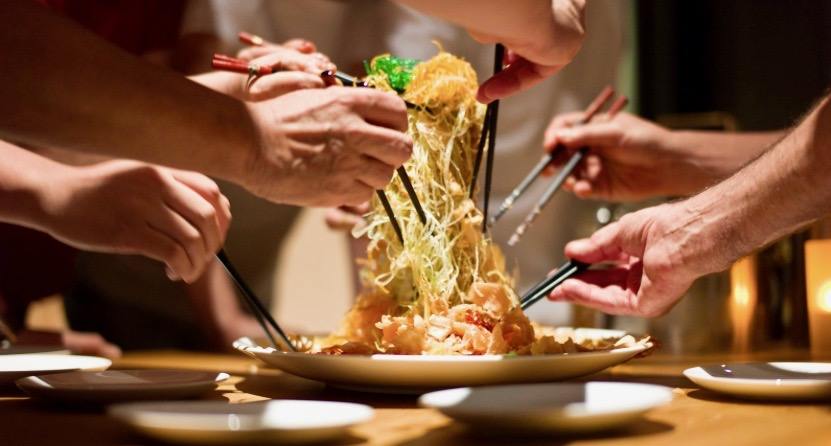
Ever heard of Yusheng, the colorful and meaningful Chinese New Year salad? It’s not just a pretty dish on the table but also packed with symbols of good fortune and well-wishes for the year ahead. Sounds exciting, right? In this article, we’ll dive into the fascinating story behind Yusheng, from its unique history and the lively “lo hei” ritual to tips on how you can make it yourself. Ready to discover this philosophy-rich dish? Let’s dig in! 🍴✨
1. What is Yusheng?
Yusheng, meaning “raw fish” in Mandarin, is a traditional Chinese New Year salad made with fresh fish like salmon as the main ingredient. It’s mixed with other components such as carrots, radishes, ginger, peanuts, sesame seeds, and sweet plum sauce. But Yusheng is more than just food—each ingredient symbolizes a specific blessing. For example, fish represents abundance, while carrots signify golden luck. The bright colors in Yusheng are also designed to bring positive energy, such as red for happiness and green for growth.
Additionally, Yusheng is often presented in a neat and aesthetic arrangement, making it a visual centerpiece during Chinese New Year celebrations. No wonder it’s the star of the dining table!
2. A Brief History of Yusheng
Yusheng originated in Southeast Asia, particularly among Chinese communities in Singapore and Malaysia. Initially, it was a simple dish, but over time, it evolved into a more festive and diverse creation. Today, Yusheng is an integral part of Chinese New Year, especially during the “lo hei” ritual, where family members toss the salad while expressing good wishes.
It’s said that the modern version of Yusheng was introduced by four famous chefs in Singapore during the 1960s. They added creative touches like plum sauce and colorful crackers to make the dish more appealing. Since then, Yusheng has gained popularity and become a cherished tradition. Interestingly, although it’s closely associated with Chinese New Year, Yusheng has also become popular among non-Chinese communities for its unique taste and positive symbolism.
3. The Meaning Behind the Lo Hei Ritual

One of the most exciting moments when enjoying Yusheng is the “lo hei” ritual. Family members gather around the table, lift their chopsticks, and toss the salad together while shouting well-wishes like “success” or “abundance of wealth.” The higher the toss, the greater the luck believed to come.
Each step of the toss follows a specific order and includes unique blessings for each ingredient. For example, when adding fish, the blessing “nian nian you yu” is recited, meaning “may you have abundance every year.” This ritual creates an interactive experience that nourishes not only the stomach but also the heart.
The lo hei ritual also reflects values of togetherness and teamwork, where everyone plays a vital role in creating harmony, both at the table and in everyday life.
4. A Delicious Yusheng Recipe
Want to try making Yusheng yourself? Here’s what you’ll need:
- Fresh fish (usually salmon sashimi)
- Thinly sliced carrots and radishes
- Mandarin oranges for a refreshing touch
- Plum sauce for sweetness
- Toppings like peanuts, sesame seeds, and colorful crackers
Mix all the ingredients, drizzle with plum sauce, and enjoy while making it lively with the “lo hei” ritual. Easy, right? For a creative twist, you can add dragon fruit or kiwi slices for extra freshness. If you like it spicy, sprinkle a bit of chili powder.
The key is to ensure all ingredients are fresh and prepared hygienically for the best Yusheng experience. Don’t forget to share the moment with family or friends to embrace the true essence of the tradition.
5. Yusheng in Modern Culinary Arts
Did you know? Traditional dishes like Yusheng are now being reimagined by modern chefs to create more exciting dining experiences. Some versions feature premium ingredients like truffle oil or tropical fruits for a fresh twist. This shows how traditions can stay relevant and innovative in the hands of creative chefs.
In high-end restaurants, Yusheng is often presented with artistic plating, like using dragon-shaped plates or symbols of luck. These innovations make Yusheng not just a dish but also an art form.
Modern chefs also draw inspiration from Yusheng to create fusion dishes, such as Yusheng sushi rolls or salad bowls with a plum sauce touch.
6. Life Lessons from Yusheng
Yusheng teaches us the importance of symbolism in food and how a dish can bring people together. For those passionate about the culinary world, understanding traditions like this is key to creating unforgettable dining experiences.
Beyond that, Yusheng emphasizes values like unity, hope, and creativity. From simple ingredients, we can craft something meaningful and beautiful. For aspiring chefs, this is a reminder that every dish tells a story worth sharing with the world.
Traditions like Yusheng also remind us to respect culture and history while continuing to innovate without losing their essence.
Make Your Culinary Dreams Come True with PIB College!
Interested in learning more about the art of cooking and culinary traditions like Yusheng? PIB College’s Culinary Arts program is the perfect place for you! Here, you’ll not only learn cooking techniques but also the philosophy behind each dish. Join us now and begin your journey to becoming an innovative and inspiring professional chef.
Written by: Stephanie Gunawan
